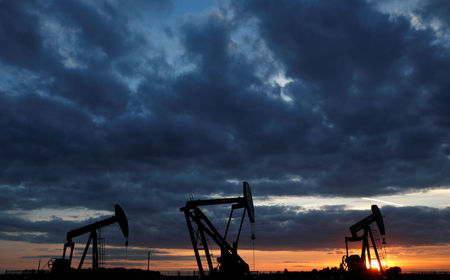Commodities
Oil prices higher after soft CPI release; US inventory draw helps

Investing.com– Oil prices rose Wednesday, helped by signs of cooling U.S. inflation, extending gains after industry data showed U.S. inventories shrank more than expected in the past week.
At 08:55 ET (12:55 GMT), rose 1.4% to $83.09 a barrel, while climbed .5% to $79.09 a barrel.
CPI increases by less than expected, Fed meeting ahead
Data released earlier Wednesday showed that U.S. increased by less than expected on an annualized basis in May, suggesting to a possible easing in price pressures that could influence how Federal Reserve policymakers see the future path of interest rates.
The Labor Department’s consumer price index rose by 3.3% last month, decelerating slightly from 3.4% in April. Month-on-month, the slowed to 0.0% from 0.3%.
Recent signs of U.S. labor market strength and sticky inflation had pointed to rates remaining high for longer – a scenario that bodes poorly for global economic growth and potentially oil demand.
Attention will now turn to the conclusion of a two-day Fed meeting later in the session.
While the central bank is widely expected to , any comments on the path of interest rates, particularly future cuts, will be in close focus.
US inventories see bigger-than-expected draw – API
Crude markets had received a boost after data from the showed on late-Tuesday that U.S. oil inventories shrank more than expected last week.
Inventories saw a draw of 2.4 million barrels (mb), more than expectations for a draw of 1.8 mb and reversing course from the 4 mb build seen last week.
Gasoline inventories saw a draw, while distillates rose slightly.
The data ramped up hopes that U.S. fuel consumption was picking up with the onset of the travel-heavy summer season. Inventory data over the past two weeks had pointed to a somewhat sluggish start to the season.
The API data usually heralds a similar reading from official , which is due later on Wednesday.
IEA cuts 2024 demand growth forecast
These gains occurred despite the International Energy Agency cutting its forecast for 2024 global crude demand by 100,000 barrels per day to 960,000 bpd, in its , citing sluggish consumption in developed countries.
The Paris-based agency also forecast global oil demand peaking by 2029 and beginning to contract the following year.
This contrasted with a more optimistic forecast from the Organization of Petroleum Exporting Countries on Tuesday, which maintained its outlook for strong global oil demand in 2024. The cartel said in its that its recent decision to maintain its output curbs presented the possibility of a supply deficit in the third quarter.
(Ambar Warrick contributed to this article.)
Commodities
Oil prices rise; U.S. crude inventories plunge, Russia-Ukraine truce eyed
Commodities
India’s Reliance to stop buying Venezuelan oil over US tariffs, sources say
Commodities
Oil prices climb on Venezuela supply worries

 Forex3 years ago
Forex3 years agoForex Today: the dollar is gaining strength amid gloomy sentiment at the start of the Fed’s week

 Forex3 years ago
Forex3 years agoUnbiased review of Pocket Option broker

 Forex3 years ago
Forex3 years agoDollar to pound sterling exchange rate today: Pound plummeted to its lowest since 1985

 Forex3 years ago
Forex3 years agoHow is the Australian dollar doing today?

 Cryptocurrency3 years ago
Cryptocurrency3 years agoWhat happened in the crypto market – current events today

 World3 years ago
World3 years agoWhy are modern video games an art form?

 Commodities3 years ago
Commodities3 years agoCopper continues to fall in price on expectations of lower demand in China

 Economy3 years ago
Economy3 years agoCrude oil tankers double in price due to EU anti-Russian sanctions























